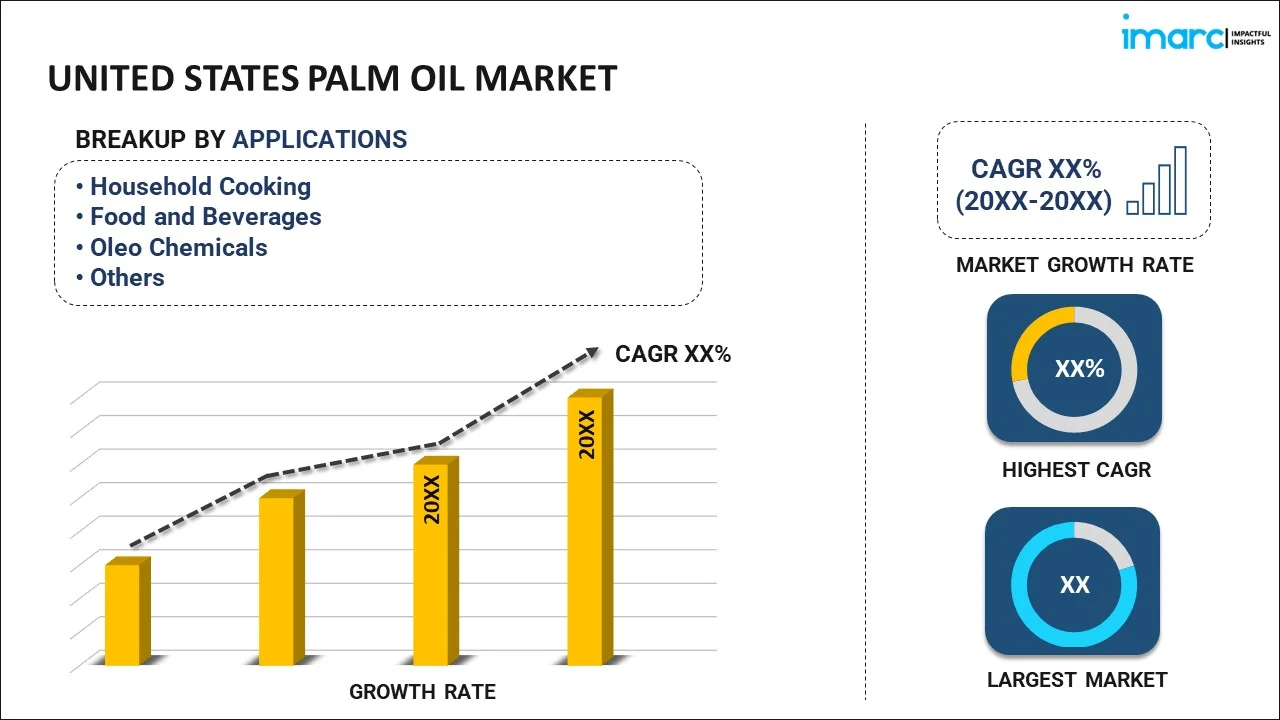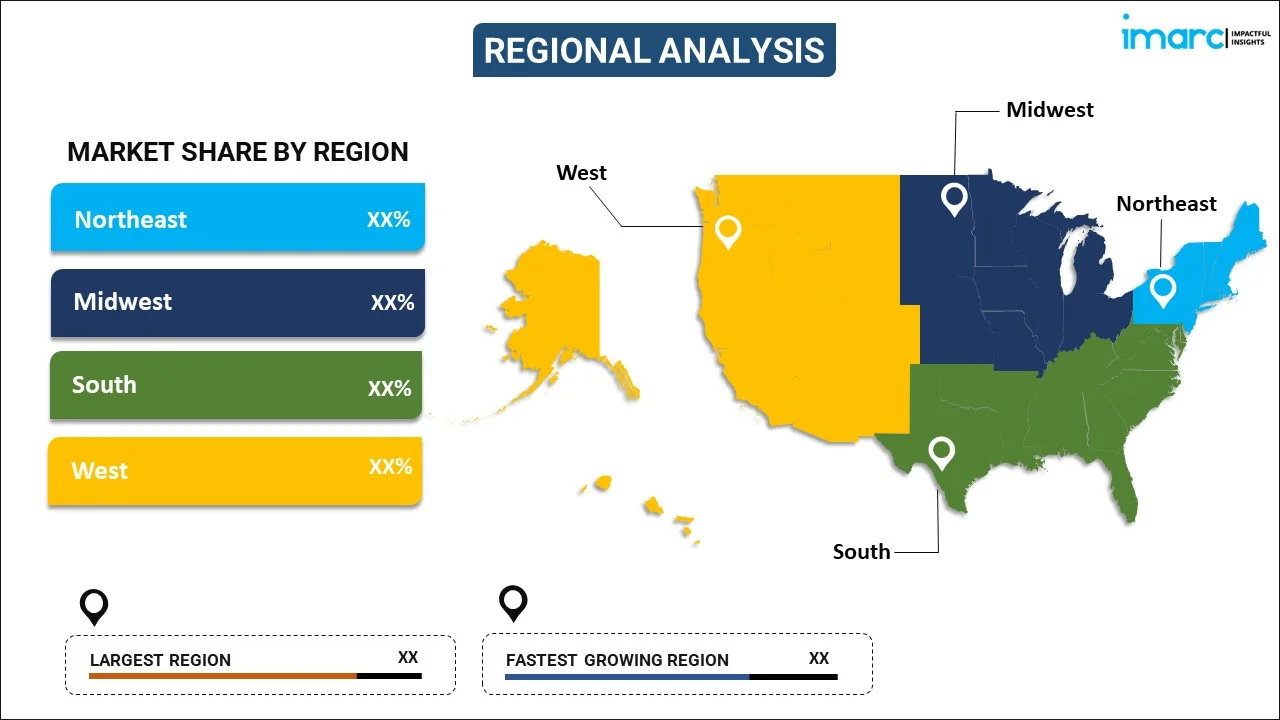
United States Palm Oil Market Report by Application (Household Cooking, Food and Beverages, Oleo Chemicals, Personal Care, Animal Feed, Bio-Fuel), and Region 2025-2033
Market Overview:
United States palm oil market size reached USD 13.8 Billion in 2024. Looking forward, IMARC Group expects the market to reach USD 21.4 Billion by 2033, exhibiting a growth rate (CAGR) of 5% during 2025-2033. The escalating demand for processed cooking oils, along with the expanding middle class population, is primarily driving the market growth across the country.
|
Report Attribute
|
Key Statistics
|
|---|---|
|
Base Year
|
2024 |
|
Forecast Years
|
2025-2033
|
|
Historical Years
|
2019-2024
|
| Market Size in 2024 | USD 13.8 Billion |
| Market Forecast in 2033 | USD 21.4 Billion |
| Market Growth Rate (2025-2033) | 5% |
Palm oil is a vegetable oil extracted from the mesocarp of oil palms, known for its extended shelf life, affordability, and significant nutritional advantages. It is cholesterol-free, easily digestible, and abundant in carotenoids and Vitamin A. These attributes contribute to its efficacy in preventing premature aging, supporting the immune system, enhancing vision, reducing the risk of cardiovascular diseases, and boosting energy levels. Due to these health benefits, palm oil finds extensive use in various industries, particularly in the food and beverage sector.
United States Palm Oil Market Trends:
The United States palm oil market is a dynamic and integral component of the nation's food and industrial sectors. Sourced from the mesocarp of oil palms, it holds a significant position due to its extended shelf life, cost-effectiveness, and notable nutritional benefits. Additionally, it is cholesterol-free, easily digestible, and rich in carotenoids and Vitamin A, contributing to its role in promoting health by preventing premature aging, supporting the immune system, improving vision, reducing the risk of cardiovascular diseases, and enhancing energy levels. This, in turn, is acting as another significant growth-inducing factor. Moreover, the United States palm oil market is characterized by its widespread application across various industries, with a prominent presence in the food and beverage sector. Besides this, its versatility makes it a key ingredient in a variety of food products, including baked goods, snacks, and cooking oils. Furthermore, as consumers increasingly prioritize health-conscious choices, the demand for palm oil is likely to see sustained growth. The market's adaptability and the multifaceted utility of palm oil underscore its importance in the American food and industrial landscape. Apart from this, the utilization of palm oil in biodiesel and other sources of renewable energy has expanded, propelled by environmental considerations and the imperative to diminish greenhouse gas emissions. Heightened awareness among health-conscious consumers and regulatory bodies in certain areas has resulted in increased examination of palm oil, particularly regarding its saturated fat content, potentially influencing market demand. This, in turn, is expected to fuel the market growth over the forecasted period.
United States Palm Oil Market Segmentation:
IMARC Group provides an analysis of the key trends in each segment of the market, along with forecasts at the country level for 2025-2033. Our report has categorized the market based on application.
Application Insights:

- Household Cooking
- Food and Beverages
- Oleo Chemicals
- Personal Care
- Animal Feed
- Bio-Fuel
The report has provided a detailed breakup and analysis of the market based on the application. This includes household cooking, food and beverages, oleo chemicals, personal care, animal feed, and bio-fuel.
Regional Insights:

- Northeast
- Midwest
- South
- West
The report has also provided a comprehensive analysis of all the major regional markets, which include Northeast, Midwest, South, and West.
Competitive Landscape:
The market research report has also provided a comprehensive analysis of the competitive landscape in the market. Competitive analysis such as market structure, key player positioning, top winning strategies, competitive dashboard, and company evaluation quadrant has been covered in the report. Also, detailed profiles of all major companies have been provided.
United States Palm Oil Market Report Coverage:
| Report Features | Details |
|---|---|
| Base Year of the Analysis | 2024 |
| Historical Period | 2019-2024 |
| Forecast Period | 2025-2033 |
| Units | Billion USD |
| Scope of the Report | Exploration of Historical and Forecast Trends, Industry Catalysts and Challenges, Segment-Wise Historical and Predictive Market Assessment:
|
| Applications Covered | Household Cooking, Food and Beverages, Oleo Chemicals, Personal Care, Animal Feed, Bio-Fuel |
| Regions Covered | Northeast, Midwest, South, West |
| Customization Scope | 10% Free Customization |
| Post-Sale Analyst Support | 10-12 Weeks |
| Delivery Format | PDF and Excel through Email (We can also provide the editable version of the report in PPT/Word format on special request) |
Key Questions Answered in This Report:
- How has the United States palm oil market performed so far and how will it perform in the coming years?
- What has been the impact of COVID-19 on the United States palm oil market?
- What is the breakup of the United States palm oil market on the basis of application?
- What are the various stages in the value chain of the United States palm oil market?
- What are the key driving factors and challenges in the United States palm oil?
- What is the structure of the United States palm oil market and who are the key players?
- What is the degree of competition in the United States palm oil market?
Key Benefits for Stakeholders:
- IMARC’s industry report offers a comprehensive quantitative analysis of various market segments, historical and current market trends, market forecasts, and dynamics of the United States palm oil market from 2019-2033.
- The research report provides the latest information on the market drivers, challenges, and opportunities in the United States palm oil market.
- Porter's five forces analysis assist stakeholders in assessing the impact of new entrants, competitive rivalry, supplier power, buyer power, and the threat of substitution. It helps stakeholders to analyze the level of competition within the United States palm oil industry and its attractiveness.
- Competitive landscape allows stakeholders to understand their competitive environment and provides an insight into the current positions of key players in the market.
Need more help?
- Speak to our experienced analysts for insights on the current market scenarios.
- Include additional segments and countries to customize the report as per your requirement.
- Gain an unparalleled competitive advantage in your domain by understanding how to utilize the report and positively impacting your operations and revenue.
- For further assistance, please connect with our analysts.
 Inquire Before Buying
Inquire Before Buying
 Speak to an Analyst
Speak to an Analyst
 Request Brochure
Request Brochure
 Request Customization
Request Customization




.webp)




.webp)












